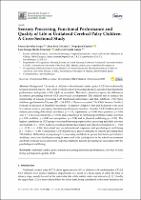Por favor, use este identificador para citar o enlazar este ítem:
https://repositorio.usj.es/handle/123456789/445
Registro completo de metadatos
| Campo DC | Valor | Lengua/Idioma |
|---|---|---|
| dc.contributor.author | Jovellar Isiegas, Patricia | - |
| dc.contributor.author | Collados, Inés Resa | - |
| dc.contributor.author | Jaén-Carrillo, Diego | - |
| dc.contributor.author | Roche-Seruendo, Luis Enrique | - |
| dc.contributor.author | García, César Cuesta | - |
| dc.date.accessioned | 2021-02-09T09:43:36Z | - |
| dc.date.available | 2021-02-09T09:43:36Z | - |
| dc.date.issued | 2020-09-28 | - |
| dc.identifier.citation | Jovellar-Isiegas P, Resa Collados I, Jaén-Carrillo D, Roche-Seruendo LE, Cuesta García C. Sensory Processing, Functional Performance and Quality of Life in Unilateral Cerebral Palsy Children: A Cross-Sectional Study. Int J Environ Res Public Health. 2020 Sep 28;17(19):7116. doi: 10.3390/ijerph17197116. PMID: 32998414; PMCID: PMC7579654. | es_ES |
| dc.identifier.issn | 1661-7827 | es_ES |
| dc.identifier.uri | https://repositorio.usj.es/handle/123456789/445 | - |
| dc.description.abstract | Background: The study of children with unilateral cerebral palsy (UCP) has traditionally focused on motor aspects. The extent to which sensory processing disorders can a ect their functional performance and quality of life (QoL) is uncertain. This study aimed to explore the di erences in sensory processing between UCP and typical development (TD) children and to analyze the relationship of sensory processing with functional performance and QoL. Methods: Fifty-three children aged from 6 to 15 years (TD = 24; UCP = 29) were recruited. The Child Sensory Profile 2, Pediatric Evaluation of Disability Inventory—Computer Adaptive Test and Kidscreen were used to evaluate sensory processing, functional performance and QoL. Results: UCP children showed sensory processing di culties (avoidance: p = 0.02; registration: p = 0.00; body position: p = 0.00; oral: p = 0.02; social-emotional: p = 0.01), and scored lower in functional performance (daily activities: p = 0.00; mobility: p = 0.00; social/cognitive: p = 0.04) and in physical well-being (p = 0.00). The highest correlations in UCP group were found between proprioceptive processing and daily activities and mobility (r = -0.39); auditory, visual and tactile information and school environment (r = -0.63; r = -0.51; r = -0.46); behavioral and social-emotional responses and psychological well-being (r = -0.64; r = -0.49). Conclusions: UCP children have greater di culty in sensory processing than TD children. Difficulties in proprioceptive processing contribute to poorer functional performance. Auditory, visual and tactile processing is associated with participation in the school environment and behavioral and social-emotional responses related to sensory processing are associated with the psychological well-being. | es_ES |
| dc.format.extent | 14 p. | es_ES |
| dc.format.mimetype | application/pdf | es_ES |
| dc.language.iso | eng | es_ES |
| dc.publisher | MDPI | es_ES |
| dc.rights | Atribución 4.0 Internacional | * |
| dc.rights.uri | http://creativecommons.org/licenses/by/4.0/ | * |
| dc.subject | Parálisis cerebral | es_ES |
| dc.subject | Procesamiento sensorial | es_ES |
| dc.subject | Presentación funcional | es_ES |
| dc.subject | Actividades diarias | es_ES |
| dc.subject | Participación | es_ES |
| dc.title | Sensory processing, functional performance and quality of life in unilateral cerebral palsy children: A cross-sectional study | es_ES |
| dc.type | info:eu-repo/semantics/article | es_ES |
| dc.subject.unesco | Calidad de vida | es_ES |
| dc.identifier.doi | 10.3390/ijerph17197116 | es_ES |
| dc.rights.accessrights | info:eu-repo/semantics/openAccess | es_ES |
| Aparece en las colecciones: | Artículos de revistas | |
Ficheros en este ítem:
| Fichero | Descripción | Tamaño | Formato | |
|---|---|---|---|---|
| Sensory Processing, Functional Performance and quality of life in unilateral cerebral palsy children.pdf | 672,79 kB | Adobe PDF |  Visualizar/Abrir |
Este ítem está sujeto a una licencia Creative Commons Licencia Creative Commons

